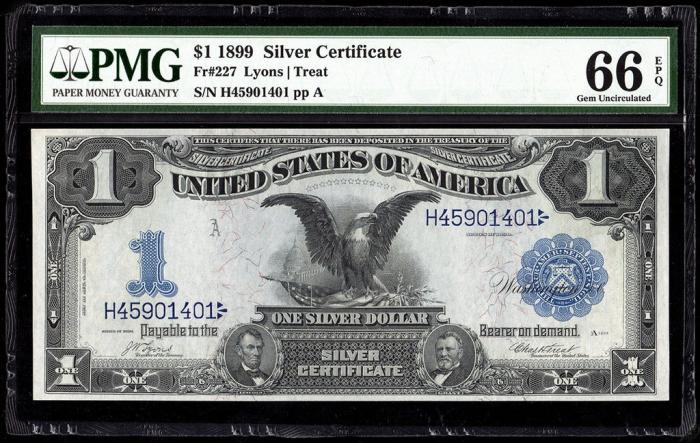The 1899 Black Eagle Silver Certificate is a notable piece of American currency history. It features a distinctive design and is highly sought after by collectors. The value of these certificates can vary significantly based on several factors. This article explores the factors influencing the worth of the 1899 Black Eagle Silver Certificate, including its historical significance, condition, rarity, and market demand.
Historical Background
The 1899 Black Eagle Silver Certificate is a product of the late 19th century, a period of significant change in U.S. currency.
1. Historical Significance
Introduced during a time of transition in American currency, the Black Eagle Silver Certificate was part of a series issued to reflect changes in monetary policy. These certificates were designed to replace earlier forms of paper currency and were issued as part of the government’s effort to standardize and stabilize the currency system.
2. Design Features
The 1899 Black Eagle Silver Certificate is named for its prominent design features. The front of the certificate showcases an eagle, the national emblem, which is depicted in a striking black color. This design was intended to symbolize strength and stability. The back of the certificate features intricate patterns and security elements, making it both functional and visually appealing.
Factors Affecting Value
The value of a 1899 Black Eagle Silver Certificate depends on various factors. Understanding these factors is crucial for anyone interested in buying, selling, or appraising these historic notes.
1. Condition
The condition of the certificate is one of the most important factors influencing its value.
Uncirculated vs. Circulated: Uncirculated notes, which have never been used as currency, are generally worth more than circulated ones. Uncirculated certificates are in pristine condition, with no signs of wear or damage. Circulated notes may show signs of folding, creasing, or staining, which can significantly affect their value.
Grading Scale: The condition of paper currency is assessed using a grading scale. The most common grading system includes grades such as Fine, Very Fine, Extremely Fine, and Uncirculated. Each grade reflects the note’s appearance and overall condition. Higher grades typically command higher prices.
2. Rarity
Rarity plays a significant role in determining the value of a 1899 Black Eagle Silver Certificate.
Number Issued: The number of certificates issued and the number that still exist today impact their rarity. Certificates that were issued in smaller quantities or those that are less frequently encountered are often more valuable.
Survivor Rate: The number of surviving examples in good condition also affects rarity. If many certificates were damaged or destroyed, those that remain in excellent condition are considered rare and can command higher prices.
3. Demand
Market demand can fluctuate based on several factors.
Collector Interest: Interest among collectors can drive up the value of a 1899 Black Eagle Silver Certificate. Collectors who focus on specific types of currency or historical periods may be willing to pay a premium for well-preserved examples.
Economic Conditions: Broader economic conditions can influence demand. During times of economic uncertainty, collectors may seek tangible assets like historical currency, potentially increasing demand and prices.
4. Historical Context
The historical context in which the certificate was issued also contributes to its value.
Historical Events: Currency issued during significant historical events or periods often has higher value. For the 1899 Black Eagle Silver Certificate, the late 19th century was a time of economic and political change, adding to its historical significance.
Notable Signatures: Certificates with signatures from notable figures or those issued during pivotal moments can be more valuable. The 1899 Black Eagle Silver Certificate features signatures from key individuals in the Treasury Department, adding to its historical interest.
Valuation and Market Trends
Understanding current market trends is essential for accurately valuing a 1899 Black Eagle Silver Certificate.
1. Recent Sales Data
Recent sales data provides insights into the current market value of the 1899 Black Eagle Silver Certificate. Prices can vary widely based on condition, rarity, and demand. Auction results and sales through specialized dealers can offer benchmarks for pricing.
2. Expert Appraisals
For an accurate valuation, seeking the expertise of a professional appraiser is recommended. Appraisers who specialize in historical currency can provide detailed assessments based on condition, rarity, and market conditions.
3. Online Marketplaces
Online marketplaces and auction sites can also provide valuable information about current values. These platforms often list certificates for sale and include details about their condition and price. Comparing listings can help gauge the market value.
Buying and Selling Tips
If you are considering buying or selling a 1899 Black Eagle Silver Certificate, keep the following tips in mind.
1. Verify Authenticity
Ensure that the certificate is authentic before making a purchase. Look for expert authentication or certification from reputable sources. Counterfeit certificates can significantly impact the value and credibility of a transaction.
2. Research Market Values
Conduct thorough research to understand current market values. Review recent sales data, consult with experts, and compare prices on reputable platforms. This will help you make informed decisions and avoid overpaying or underselling.
3. Preserve the Certificate
Proper preservation of the certificate is crucial for maintaining its value. Store the certificate in a controlled environment, away from light, moisture, and excessive handling. Use protective sleeves or holders to prevent damage.
See also: How Much Is a James Monroe Gold Dollar Worth?
Conclusion
The 1899 Black Eagle Silver Certificate is a fascinating piece of American currency history with a value influenced by several factors. Its historical significance, design features, condition, rarity, and market demand all play crucial roles in determining its worth. By understanding these factors and staying informed about market trends, collectors and investors can make informed decisions regarding the value and purchase of these historic certificates. Whether you are a collector, investor, or simply interested in American currency, the 1899 Black Eagle Silver Certificate remains a valuable and intriguing artifact from the late 19th century.

